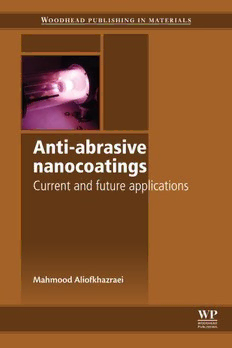
Anti-abrasive nanocoatings : current and future applications PDF
Preview Anti-abrasive nanocoatings : current and future applications
Anti-Abrasive Nanocoatings Related Titles Coatingsforbiomedicalapplications (ISBN978-1-84569-568-2) Metalsforbiomedicaldevices (ISBN978-1-84569-434-0) Advancesinmarineantifoulingcoatingsandtechnologies (ISBN978-1-84569-386-2) Woodhead Publishing in Materials Anti-Abrasive Nanocoatings Current and future applications Edited by Mahmood Aliofkhazraei AMSTERDAM(cid:129)BOSTON(cid:129)HEIDELBERG(cid:129)LONDON NEWYORK(cid:129)OXFORD(cid:129)PARIS(cid:129)SANDIEGO SANFRANCISCO(cid:129)SINGAPORE(cid:129)SYDNEY(cid:129)TOKYO WoodheadPublishingisanimprintofElsevier WoodheadPublishingLimitedisanimprintofElsevier 80HighStreet,Sawston,Cambridge,CB223HJ,UK 225WymanStreet,Waltham,MA02451,USA LangfordLane,Kidlington,OX51GB,UK Copyright©2015ElsevierLtd.Allrightsreserved. Nopartofthispublicationmaybereproducedortransmittedinanyformorbyanymeans, electronicormechanical,includingphotocopying,recording,oranyinformationstorageandretrieval system,withoutpermissioninwritingfromthepublisher.Detailsonhowtoseekpermission,further informationaboutthePublisher’spermissionspoliciesandourarrangementswithorganizationssuch astheCopyrightClearanceCenterandtheCopyrightLicensingAgency,canbefoundatour website:www.elsevier.com/permissions. Thisbookandtheindividualcontributionscontainedinitareprotectedundercopyright bythePublisher(otherthanasmaybenotedherein). Notices Knowledgeandbestpracticeinthisfieldareconstantlychanging.Asnewresearchandexperience broadenourunderstanding,changesinresearchmethods,professionalpractices,ormedicaltreatment maybecomenecessary. Practitionersandresearchersmustalwaysrelyontheirownexperienceandknowledgeinevaluating andusinganyinformation,methods,compounds,orexperimentsdescribedherein.Inusingsuch informationormethodstheyshouldbemindfuloftheirownsafetyandthesafetyofothers, includingpartiesforwhomtheyhaveaprofessionalresponsibility. Tothefullestextentofthelaw,neitherthePublishernortheauthors,contributors,oreditors, assumeanyliabilityforanyinjuryand/ordamagetopersonsorpropertyasamatterofproducts liability,negligenceorotherwise,orfromanyuseoroperationofanymethods,products, instructions,orideascontainedinthematerialherein. ISBN:978-0-85709-211-3(print) ISBN:978-0-85709-217-5(online) BritishLibraryCataloguing-in-PublicationData AcataloguerecordforthisbookisavailablefromtheBritishLibrary LibraryofCongressCataloging-in-PublicationData AcatalogrecordforthisbookisavailablefromtheLibraryofCongress LibraryofCongressNumber:2014955911 ForInformationonallWoodheadPublishingpublications visitourwebsiteathttp://store.elsevier.com/ TypesetbyMPSLimited,Chennai,India www.adi-mps.com PrintedandboundintheUS Contents Listoffigures xi Listoftables xxiii Abouttheeditor xxv Aboutthecontributors xxvii Preface xli Part One 1 1 Wear,frictionandpreventionoftribo-surfaces bycoatings/nanocoatings 3 SunilMohanandAnitaMohan 1.1 Introduction 3 1.2 Frictionofmaterials 4 1.3 Wearinmetals,alloysandcomposites 10 1.4 Materialsandtheirselectionforwearandfrictionapplications 12 1.5 Coatings/nanocoatingsandsurfacetreatments 15 1.6 Conclusion 19 Acknowledgements 19 References 19 2 Aninvestigationintothetribologicalpropertyofcoatings onmicro-andnanoscale 23 XuesongHan 2.1 Driversofstudyingtheoriginoftribologybehavior 23 2.2 Contactatnanometerscale 27 2.3 Atomicfrictionwithzeroseparation 37 2.4 Scratchingwearatatomicscale 47 2.5 Conclusion 54 References 54 3 Stressonanti-abrasiveperformanceofsol-gelderivednanocoatings 57 ShengzhaoWang 3.1 Classicalcurvaturestressforthinfilmsonplatesubstrates 58 3.2 Thermal stressofthinfilms 61 3.3 Whydodryingfilmscrack? 61 3.4 Cracksbystresscomefromconstraintofshrinkage bythesubstrate 63 3.5 Rapidsol-gelfabricationtoconfronttensiletrailingcracks 66 vi Contents 3.6 Anti-abrasiveSiO filminapplication:self-assembling 2 covalentlybondednanocoating 68 3.7 Abrasivetest 69 3.8 Anti-abrasiveperformanceofsol-gelnanocoatings 72 3.9 Conclusion 76 Acknowledgments 77 References 77 4 Self-cleaningglass 81 KrishnanSurekhaandSureshbabuSundararajan 4.1 Introduction 81 4.2 Historyofglass 83 4.3 Self-cleaningglass 84 4.4 Hydrophiliccoating 85 4.5 Anti-reflectivecoating 86 4.6 Porousmaterials 86 4.7 PhotocatalyticactivityofTiO 88 2 4.8 Hydrophobiccoatings 89 4.9 Fabricationofself-cleaningglass 90 4.10 Applicationofself-cleaningglasses 99 Acknowledgements 99 References 99 5 Sol-gelnanocompositehardcoatings 105 RamachandraS.R.KalidindiandRaghavanSubasri 5.1 Introduction 105 5.2 Sol-gelnanocompositehardcoatings 106 5.3 Mechanicalpropertystudiesofsol-gelhardcoatings onvarioussubstrates 110 5.4 Possibleapplicationsofhardcoatings 129 5.5 Summary 132 Acknowledgments 132 References 132 6 Processconsiderationsfornanostructuredcoatings 137 KalRenganathanSharma 6.1 Overview 137 6.2 Anti-reflectioncoatings 140 6.3 Fluidizedbedmethod 143 6.4 Electroplating 144 6.5 Nanografting 145 6.6 Plasmaspraycoating 145 6.7 Nanostructuringinthinfilms 146 6.8 Electrochemicaldeposition 147 6.9 Anti-corrosioncoating 149 6.10 Infraredtransparentelectromagneticshielding 149 Contents vii 6.11 Underlyingscience(cid:1)self-assembly 150 6.12 Conclusions 151 References 152 Part Two 155 7 Nanostructuredelectrolessnickel-boroncoatingsforwearresistance 157 Ve´roniqueVitryandFabienneDelaunois 7.1 Introduction 157 7.2 Synthesisofelectrolessnickel-boroncoatings 157 7.3 Morphologyandstructureofelectrolessnickel-boroncoatings 171 7.4 Mechanicalandwearpropertiesofnanocrystallineelectroless nickel-boroncoatings 178 7.5 Corrosionresistance 191 7.6 Conclusion 192 References 195 8 Wearresistanceofnanocompositecoatings 201 VaheVardanyan,BouddahPoaty,Ve´ronicLandry,GregoryChauve, TigranGalstian,andBernardRiedl 8.1 Introduction 201 8.2 Materialsandmethods 206 8.3 Resultsanddiscussion 211 8.4 Conclusions 220 Acknowledgments 220 References 221 9 Machiningmedicalgradetitaniumalloysusingnonabrasive nanolayeredcuttingtools 225 MarkJ.Jackson,RodneyG.Handy,MichaelD.Whitfield, JohnW.Burgess,GrantM.Robinson,TamaraNovakov, WaqarAhmed,AhmedM.Elhissi,StJohnJ.Crean,DavidA. Phoenix,A´lissonRochaMachado,andMarcioBaccidaSilva 9.1 MetallurgicalAspects 225 9.2 Machiningoftitaniumalloys 233 9.3 Machiningwithcoatedcuttingtools:acasestudy 234 9.4 Conclusions 246 Acknowledgments 246 References 246 10 Functionalnanostructuredcoatingsvialayer-by-layer self-assembly 249 KatalinHalasz,GeorgeGrozdits,andLeventeCso´ka 10.1 Introduction 249 10.2 LbLprocess 250 viii Contents 10.3 LbL-depositednanostructuredcoatingswithdifferentfunctions 258 10.4 Conclusions 277 Acknowledgment 277 References 277 11 Theoreticalstudyonaninfluenceoffabricationparameters onthequalityofsmartnanomaterials 283 VelaphiMsomi 11.1 Introduction 283 11.2 LiteraturesurveyonVO 284 2 11.3 Synthesistechniquesdescription 288 11.4 Conclusion 291 References 291 12 Formationofdensenanostructuredcoatingsbymicroarc oxidationmethod 293 VladimirN.Malyshev 12.1 Introduction 293 12.2 PhenomenaofMAO-coatingformation 293 12.3 Voltage(cid:1)currentcharacteristics 295 12.4 Discussionaboutgrowthmechanism ofMAOcoating 297 12.5 Modeloffractalgrowthofthedensewear-resistantlayer 301 12.6 Macro-andmicrostructureofMAOcoatings 309 12.7 Wear-resistantproperties 315 12.8 Conclusion 327 References 327 13 Currenttrendsinmolecularfunctionalmonolayers 331 PrashantK.Sarswat,AmarchandSathyapalan,andMichaelL.Free 13.1 Introduction 331 13.2 Stepsforself-assembly 332 13.3 Mechanism 335 13.4 CharacterizationofSAMs 336 13.5 UseofSAMsforvariousapplications 337 13.6 Self-assembledmonolayersongoldsubstrates 341 13.7 Si-CmonolayerformationandC-Cbonding 342 13.8 Supramolecularassemblyonsurface(cid:1)host-guestinteractions andothernon-covalentbonding 344 13.9 Self-assembledmonolayersonothersurfacessuch astitaniananotubes 344 13.10 Chemicalandelectricalbiosensors 345 13.11 Qualityimprovement 345 13.12 Conclusions 346 References 347 Contents ix 14 Surfaceengineerednanostructuresonmetallicbiomedical materialsforanti-abrasion 349 KelviiWeiGuo 14.1 Introduction 349 14.2 Surfacetechnologiesonmetallicbiomedicalmaterials foranti-abrasion 353 14.3 Futureprospects 375 References 376 15 Theoreticalmodelingoffrictionandwearprocesses atatomiclevel 385 YuriF.Migal 15.1 Introduction 385 15.2 MDmethod 387 15.3 Quantumchemistrymethods 389 15.4 Basictypesofproblems 391 15.5 Lubricationandone-electrontransfers 400 15.6 Conclusion 402 References 403 16 Mechanicalcharacterizationofthinfilmsbydepth-sensing indentation 407 JorgeM.Antunes,Jose´V.Fernandes,andNatalyiaA.Sakharova 16.1 Introduction 407 16.2 Hardness 408 16.3 Young’smodulus 414 16.4 Conclusion 422 Acknowledgements 422 References 423 Part Three 427 17 Advancedbulkandthinfilmmaterialsforharshenvironment MEMSapplications 429 CinziaCaliendoandFabioLoCastro 17.1 Introduction 429 17.2 Piezoelectricsubstrates 431 17.3 Non-piezoelectricsubstrates 436 17.4 Thinpiezoelectricfilms 437 17.5 Metalelectrodes 444 17.6 Conclusion 447 References 447
